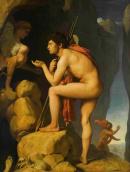Oedipus explains the enigma of the Sphinx by Jean-Dominique Ingres
A masterpiece from the Louvre at the Musée
Oedipus explains the enigma of the Sphinx by Jean-Dominique Ingres
05 November 2021 – 14 March 2022
A special guest will be on display in the North Wing of the museum on 5 November. Oedipus and the Sphinx is a masterpiece by Ingres, Delacroix's famous rival.
On loan from the Louvre in exchange for Delacroix's Greece on the Ruins of Missolonghi, presented in Paris to celebrate the bicentenary of the Greek War of Independence, its work will be displayed in conversation with the works in the Romantic Room, recalling the aesthetic battle between the champions of colour and the supporters of drawing at the 1827 Salon. That year, Ingres took his first "missive from Rome", painted in 1808 after the living model and a famous antique, and turned it into a larger history painting, where archaism competes with modernity. The subject, taken from Greek mythology, confronts the naked Oedipus with the hybrid figure of the Sphinx (female face and bust, lion's body and bird's wings), entrenched in the shadow of a cave, in contrast to the luminous opening of the rocky cavity.
The young hero must solve the riddle posed by the monster, which tests travellers who pass through this region of Thebes: "What is the being with a voice that has four feet in the morning, two at noon and three at night? "The presence of human bones and the frightened expression of Oedipus' companion, fleeing in the background, remind us that any false answer is fatal. Oedipus' beauty and intelligence will triumph over the curse while condemning him to his doomed fate as an incestuous and parricidal son. This theme appealed to other 19th-century artists, such as Gustave Moreau, who favoured a more carnal, hand-to-hand approach. In the 1980s, Francis Bacon gave a very free interpretation of the Ingresque version, proof of the fascination that this enigmatic work has always had on the collective imagination. The answer awaits you at the museum...
Ingres, an innovative painter
Jean-Auguste-Dominique Ingres (1780-1867), champion of the doctrine of ideal beauty and the primacy of drawing over colour, opposed the Romantic and then the Realist movements. At first often lectured by critics, he developed a style at the crossroads of academicism and artistic innovation, notably by exaggerating the elongation of bodies. A pupil of David, Ingres sought to assert himself through historical painting, mythological scenes and particularly ancient inspiration. His genius preserved him from overly rigid classifications and, at the beginning of the 20th century, attracted the admiration of artists such as Degas, Renoir, Matisse and Picasso, who were fascinated by his anatomical deformations and the purity of his graphic line.








